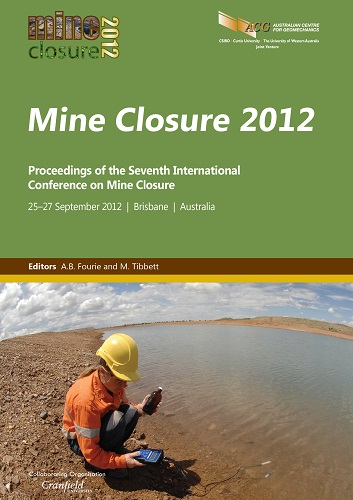Closure planning in a developing country – a case study from the Phu Kham Mine, Laos, Southeast Asia

|
Authors: Mauric, AP; McCullough, CD; Wilson-Clark, C; Witcomb, A; Millgate, J |
DOI https://doi.org/10.36487/ACG_rep/1208_27_Mauric
Cite As:
Mauric, AP, McCullough, CD, Wilson-Clark, C, Witcomb, A & Millgate, J 2012, 'Closure planning in a developing country – a case study from the Phu Kham Mine, Laos, Southeast Asia', in AB Fourie & M Tibbett (eds), Mine Closure 2012: Proceedings of the Seventh International Conference on Mine Closure, Australian Centre for Geomechanics, Perth, pp. 295-303, https://doi.org/10.36487/ACG_rep/1208_27_Mauric
Abstract:
Mining in developing regions face significant challenges for effective closure planning. A regulatory environment that has not reached maturity in the area of mine closure and limited capacity within government to regulate mine closure issues can present considerable risk from an operation to the regional community and environment. Alternatively, if the operation adopts leading practice international standards in recognition of their corporate responsibilities and social license-to-mine in developing countries, there may be significant opportunities for enhanced social and environmental outcomes for the host country and mining company. Using a case study from the Phu Kham Mine, Lao People’s Democratic Republic (Laos), we discuss some of the key challenges to closure planning, including the limitations of closure regulation and community capacity to assimilate closure issues, in a developing country. We describe how leading mine closure planning can be achieved in a developing country using leading practice international standards. The practical application of these standards is already leading to significant social outcomes in the areas of community development through initiatives targeting health, education and economic opportunities. When planning for closure, the focus must shift towards a longer term view, which endeavours to use the remaining years of the operation to prepare local communities for post-mining independence and sustainable benefits. We highlight the potential for both social and environmental benefits post-closure and the degree of planning required to get there.
References:
ANZMEC/MCA (2000) Strategic Framework for Mine Closure, by Australian and New Zealand Minerals and Energy Council/Minerals Council of Australia, Canberra, Australia, 27 p.
Bridge, G. (2004) Contested terrain: mining and the environment, Annual Review of Environment and Resources, Vol. 29,
pp. 205–259.
Burke, G. (2006) Opportunities for environmental management in the mining sector in Asia, The Journal of Environment and Development, Vol. 15, pp. 224–235.
Clark, I. (1999) Planning for closure: The case of Australia, A. Warhurst and L. Noronha (eds), Environmental policy in mining: Corporate strategy and planning for closure, Boca Raton, USA, Lewis Publishers.
Cochilco (2002) Research on mine closure policy, by Cochilco, Chilean Copper Commission, Santiago, Chile, 94 p.
Dhindsa, H.S., Battle, A.R. and Prytz, S. (2003) Environmental emission of mercury during gold mining by amalgamation process and its impact on soils of Gympie, Australia, Pure and Applied Geophysics, Vol. 160, pp. 145–156.
DMP/EPA (2011) Guidelines for preparing mine closure plans, by Western Australian Department of Mines and Petroleum (DMP), Environmental Protection Authority of Western Australia (EPA), Perth, Australia, 78 p.
Finucane, S., Soeprapto, P., Wiryanto, K. and Ainscough, T. (2011) Challenges and opportunities for mine closure planning in Indonesia, in Proceedings Sixth International Conference on Mine Closure (Mine Closure 2011), A.B. Fourie, M. Tibbett and A. Beersing (eds), 19–21 September 2011, Lake Louise, Canada, Australian Centre for Geomechanics, Perth, Vol. 1,
pp. 393–403.
Harrison, J., Heijnis, H. and Caprarelli, G. (2003) Historical pollution variability from abandoned mine sites, Greater Blue Mountains World Heritage Area, NSW, Australia, Environmental Geology, Vol. 43, pp. 680–687.
ICMM (2008) Planning for Integrated Mine Closure: Toolkit, by International Council on Mining and Metals London, UK, 86 p.
wcm/connect/1f4dc28048855af4879cd76a6515bb18/Final%2B-%2BMining.pdf?MOD=AJPERES&id=1323153264157.
Johnson, D.B. (2003) Chemical and microbiological characteristics of mineral spoils and drainage waters at abandoned coal and metal mines, Water, Air, & Soil Pollution: Focus, Vol. 3, pp. 47–66.
Jones, H. (1996) Minesite closure – a government perspective, AMPLA Yearbook, pp. 464–474.
Jones, H. (2008) Closure objectives, guidelines and actual outcomes, in Proceedings Third International Seminar on Mine Closure (Mine Closure 2008), A.B. Fourie, M. Tibbett, I.M. Weiersbye, P. Dye (eds), 14–17 October 2008, Johannesburg, South Africa, Australian Centre for Geomechanics, Perth, pp. 245–254.
Laurence, D.C. (2002) Optimising mine closure outcomes for the community – lessons learnt, Minerals and Energy – Raw Materials Report, Vol. 17, pp. 27–38.
Lottermoser, B.G. (2007) Mine Wastes: characterization, treatment, environmental impacts, 2nd ed, Springer, New York, USA, 300 p.
MCA (2005) Enduring Value: Australian Minerals Industry Framework for Sustainable Development, by Minerals Council of Australia, Canberra, Australia, 24 p.
McCullough, C.D. and Van Etten, E.J.B. (2011) Ecological restoration of novel lake districts: new approaches for new landscapes, Mine Water and the Environment, Vol. 30, pp. 312–319.
Navarro, M., Pérez-Sirvent, C., Martínez-Sánchez, M., Vidal, J., Tovar, P. and Bech, J. (2008) Abandoned mine sites as a source of contamination by heavy metals: A case study in a semi-arid zone, Journal of Geochemical Exploration, Vol. 96, pp. 183–193.
Rio Tinto (2009) Closure Standard, Rio Tinto London, UK, 11 p.
Roldan, C.F. and Purvance, D. (2011) San Martin Mine in Honduras – from closure to sustainability, in Proceedings Sixth International Conference on Mine Closure (Mine Closure 2011), A.B. Fourie, M. Tibbett and A. Beersing (eds), 19–21 September 2011, Lake Louise, Canada, Australian Centre for Geomechanics, Perth, Vol. 2, pp. 461–470.
Sklenička, P. and Kašparová, I. (2008) Restoration of visual values in a post-mining landscape, Journal of Landscape Studies, Vol. 1, pp. 1–10.
Wälde, T. (1992) Environmental policies towards mining in developing countries, Journal of Energy and Natural Resources Law, Vol. 10, pp. 327–351.
World Bank (2010) Towards sustainable decommissioning and closure of oil fields and mines: A toolkit to assist government agencies, W.B.M. Initiative, Washington, DC, The World Bank.
© Copyright 2025, Australian Centre for Geomechanics (ACG), The University of Western Australia. All rights reserved.
View copyright/legal information
Please direct any queries or error reports to repository-acg@uwa.edu.au
View copyright/legal information
Please direct any queries or error reports to repository-acg@uwa.edu.au